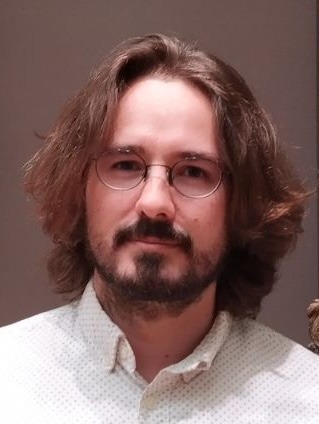Lucien DUPUY
Postdoctoral Researcher
✉️ lucien.dupuy[at]unistra.fr
SUPERVISOR: Emmanuel FROMAGER

Research Topics
My research focuses on the numerical simulation of non-adiabatic processes taking place in molecules, such as the relaxation following excitation by light. This remains a very challenging problem both from the high cost-to-accuracy ratio of electronic structure calculations for excited states and from the intricacies of retaining a good description of electro-nuclear dynamical correlations within a practical non-adiabatic dynamics method.
I am focusing on method developments to address these outstanding problems. My PhD at University of Montpellier (Yohann Scribano’s group) and my Postdoc at Rutgers University (Neepa Maitra’s group) focused on methods for dynamics using quantum trajectories and mixed quantum-classical methods based on Exact Factorization. In my current position at LCQS (Emmanuel Fromager’s group), I started tackling the electronic structure problem through different flavors of Density Functional Theory.
Beyond the Born-Oppenheimer Picture with a Density Functional Theory of Electrons and Nuclei
When computing ground- or excited-states properties through Kohn Sham or time-dependent DFT, one invokes the Born-Oppenheimer separation between electrons and nuclei, so that properties of the former are considered at a fixed geometry of the latter. This BO separation breaks down however at geometries in the vicinity of conical intersections, i.e. degeneracies of electronic states. It is especially problematic when the conical intersection involves the ground electronic state, because of the single-reference character of TDDFT. Electrons and nuclei need to be treated jointly if one wants to overcome failures of the BO approximation, and to this end, I am working on a density functional theory of both electrons and nuclei introduced by Benjamin Lasorne and Emmanuel Fromager (see https://doi.org/10.1088/2516-1075/ad45d5 ).
Time-Independent Density Functional Theory beyond the ground state: Ensemble DFT
Ensemble DFT (EDFT) extends the framework of standard Kohn-Sham DFT to an ensemble of (ground and excited) states, allowing to access properties of excited states within a static setting. Its framework offers advantages over time-dependent DFT, the workhorse in the field, such as treating degeneracies and accounting for states of double-excitation character. For a long time however, the complex task of building exchange and correlation functionals incorporating dependence on ensemble weights has held back its widespread use. It is now going through a renaissance, with historical limitations being pushing back at a galvanizing pace.
In my current position, I am working with Emmanuel Fromager to extend EDFT formalism, introducing ways to compute previously unavailable individual-state properties.
Our recent work on determining state-specific static response functions in principle exactly within the EDFT framework can be found here:
https://doi.org/10.48550/arXiv.2506.16363
Improving on practical mixed quantum-classical methods for non-adiabatic dynamics with the Exact Factorization
Treating nuclei as classical trajectories while retaining a quantum treatment of electrons brings a massive reduction in computational requirements for molecular simulations. Physically, it is also sound for many photochemical processes in which strong quantum nuclear effects, such as tunneling, are not competitive with kinetic (classical-like) factors in driving a reaction. Yet, building mixed quantum-classical methods has proven very challenging. The crucial point is to model the dynamical feedback between electrons and nuclei in the limit where they are treated with a completely different level of theory. What force should drive nuclei when the electronic cloud is in a superposition of states? What potential should drive the electronic dynamics in return? The Exact Factorization formalism brought insights on how to improve on usual mixed quantum-classical methods through dynamical correlation terms.
During my postdoc at Rutgers University, I introduced a new Surface Hopping method correcting both the electronic decoherence problem and the velocity rescaling of nuclei by combining Exact Factorization-based electronic evolution and a non-adiabatic quantum force acting on nuclei. In predicting the photo-relaxation of Uracil Cation, this new method named QTSHXF (Quantum Trajectory Surface Hopping with Exact Factorization) outperformed state-of-the-art MQC approaches. You can read about it here:
https://doi.org/10.1021/acs.jpclett.4c00115
Using Machine Learning to speed up non-adiabatic dynamics simulations
In mixed-quantum classical methods for non-adiabatic dynamics, the classical-like treatment of nuclear motion allows for an enormous decrease in computational cost so that the main bottleneck for pushing simulations to longer times or larger molecules becomes performing electronic structure calculations at every time-step. All dynamical methods which do not compromise on accuracy further than the quantum-classical approximation need energies, forces and non-adiabatic couplings (NACs) between electronic states. To decrease computational cost, using deep neural networks (DNN) to learn these three quantities from a small set of Ab Initio calculations is very promising.
While at Rutgers University I worked on adding excited-states capabilities to DeepMD, a very powerful DNN framework built on an atomic embedding principle to model ground state energy and forces of extended systems. During this study, I realized a fundamental flaw with which NACs were modeled by DNN architectures, strongly impeding their accurate learning through unphysical symmetries and phases. I built adapted descriptors and predictors that learn couplings faithfully within the very efficient DeePMD framework. You can read about it here:
